by Carolyn Edlund
Headed to an art or craft fair? Here’s your success guide to make the most of every show.
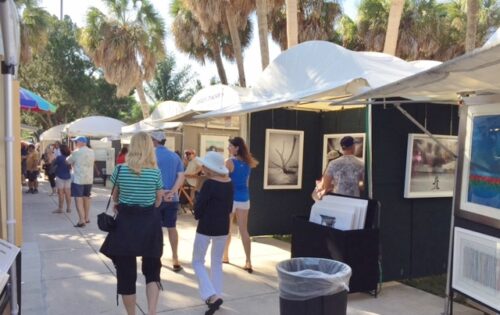
Fairs provide you an opportunity to introduce your art to new people who experience it in person. As a bonus, they can have a conversation with you as the artist or maker. This is a great way to build relationships and gain customers, fans and prospects for your growing business.
Below is a list of tips to ensure a smooth experience at your next fair. Let’s get started:
Arrive Early and Stay Late
Arrive at the venue with plenty of time to spare before the fair opens. Plan to arrive at least a couple of hours before the start to get everything accomplished. This will depend on the time you know from experience you need to unpack and set up your exhibit booth, stock it, park your vehicle and even grab some coffee before fair visitors filter in.
If anything can go wrong, it often does. Lateness due to traffic jams or delays sets the tone for a stressful day. When you allow plenty of time to set up your booth thoughtfully and professionally, you will be truly ready to face the day with a positive start.
Come Prepared to Do Business
Every artist will have their own unique checklist, but many items are standard across the board and should go to every show. This is in addition to your booth setup, lighting, display equipment and the stock you determine you will need. Here are some items most artists need in their “go bag”:
* Instructions from the show promoter
* Plenty of change for cash purchases
* Insurance documents
* Booth signage
* Cell phone, card reader and charger
* A method to track sales
* Pens and notepad
* Business cards
* Marketing collateral
* Guest book (or QR code) to capture visitor names and email addresses
* Packaging, scissors, tape and bags or wrap for purchases
* Bottled water
* Snacks or lunch in a cooler
* Any medication you need
Bring Work in a Range of Formats and Price Points
Retail show audiences vary, so you need to be familiar with each upcoming fair to determine the exact mix of work to bring for you display and as backstock. Do some research and planning first and pack your stock accordingly. In general, a show will have attendees with a variety of pocketbooks, so provide a good range of prices to accommodate them.
Include items at entry-level pricing levels as gifts, for impulse buying and to appeal to new buyers. Mid-level prices are often the bulk of sales, and work in this category is usually your “bread and butter” items. The high-end aspirational pieces can function as visual statements that attract the eye and lead visitors into your booth. They often work to entice buyers who may end up with a lesser-priced purchase. Those expensive items will also sometimes sell, making you glad that you offered them in your booth to capture more affluent collectors.
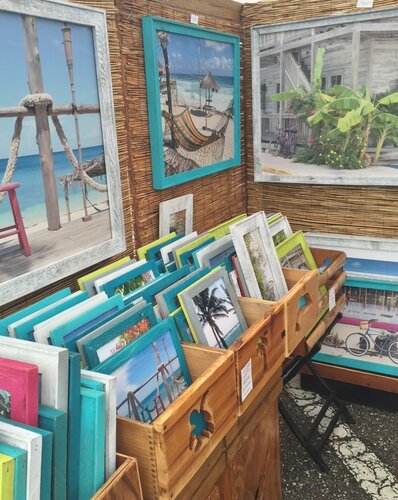
An Organized and Accessible Booth Display
Your art or craft work is the star of the show, and deserves to be shown in a professional, uncluttered manner. A booth exhibit that looks more like a gallery is often the best way to display fine art. Give each piece breathing room by leaving space around it and lighting it beautifully. This is especially important with higher-end originals and will add to their perceived value.
Separately, a bin of reproductions or smaller work can be used to consolidate space while giving a good selection of lower priced art. Make sure prices are prominently shown to avoid confusing customers.
If you are selling craftwork made in production, a clean and organized display is essential. Cluttered bins or overly full racks can give the impression that the products are commodities rather than beautifully handmade pieces. Decluttering also avoids a situation where shoppers become overwhelmed with too many choices. Keep your selection reasonable, and replace stock as items sell. If a customer is looking for something specific that might be in backstock, keep a box handy for them to look through. This often gives the impression that they are getting an inside look at your stock and can drive more sales.
Professional Presentation
From beautiful signage to the flooring in your booth, everything matters to give your “shop” the best look to appeal to the customers you want. The layout and materials you use to build your booth will depend on whether the show is inside or outdoors, the availability of electricity, and the amount of space you have.
Make sure your display has visual appeal, both in height and depth. An inviting booth with an open front, visible signage, and prominent work up front creates interest and improves visibility. It is one of the most important elements in great booth display; a dark booth is uninviting and discourages shoppers. Use LED lights set up from multiple directions to enhance the entire presentation, with spotlights to highlight individual works.
Artists often use commercially made display units that are lightweight, durable and highly functional to display two-dimensional art. Your booth can also benefit from a multi-level layout. Use tables and tabletop displays like risers or small shelving units to elevate work for sale. Eye level is “buy level” at retail, which makes it prime placement for your bestsellers.
Cases for fine jewelry or small high-end items are essential for artists who work in those categories. Other types of display units can be useful, like clothing racks, small baskets for pick-up items, shelving or even hanging displays to take advantage of all the real estate in your booth. A varied look in your exhibit booth attracts attention and allows customers to see what you are selling even with large show crowds.
When stocking your booth, make sure your work is accessible, easy to handle and inspect, unless you have valuable small pieces like jewelry. In that case, be available to pull out individual pieces to show customers. When you do so, place the item in the prospect’s hand. This is a sales technique that often closes the sale.
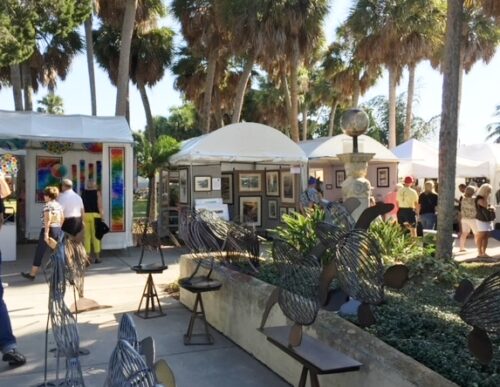
Customer Engagement
Show hours can be long and tiring, but each fair is a huge opportunity to connect with customers, prospects and even future opportunities. You must be present and positive, looking for the benefits you will get from each show. Sales are obviously desirable, but often the contact you make at a fair is just the entry point for customers who will buy later. That’s why it is so important to engage with booth visitors.
Make eye contact and smile. Acknowledge every person who approaches your booth. Put away your phone, books, food or other distractions when customers are in your booth. Stand or use a director’s chair rather than sitting at a level lower than customers. You should be ready to answer questions, demonstrate products, or share the story behind your work. Be present and available for conversation without hovering or applying sales pressure. People feel comfortable browsing in your booth and learning more about you and your creative work when you cultivate a low pressure, welcoming environment.
One of the most important things you can do at any fair or event is to capture names and email addresses of interested shoppers to use for future email marketing. This may be in the form of a simple guest book, or you could use a QR code to make signing up easy. Send a follow up email a few days after the show to thank them for stopping by, remind them of your work, and invite them to visit your website to learn more.
Marketing Collateral
Collateral includes physical and even digital sales materials to enhance visitors’ experience of your work. Business cards, postcards, flyers, brochures, QR codes leading to your online store, and your website address are some of them.
Collateral may contain images of your collection, an invitation to a studio sale, list of upcoming events, information about commissions, care instructions for your products, or even coupons for future purchases. Make sure your contact information is prominent, with social media profile links included as well.
The point of collateral is much the same as collecting email addresses; it enables you to continue to build customers relationships beyond the art or craft fair and encourages your fans to make future purchases online or in person.
Secure a Successful Show
By following these guidelines, you’ll maximize your craft fair success while presenting yourself as a real pro. Each fair is a learning experience, so take notes about what works best for your specific products and customers. As you learn what works best for you, adapt your strategy to plan for future fairs.
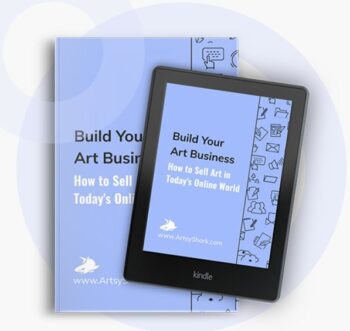

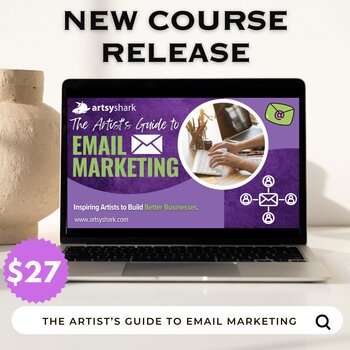

Speak Your Mind